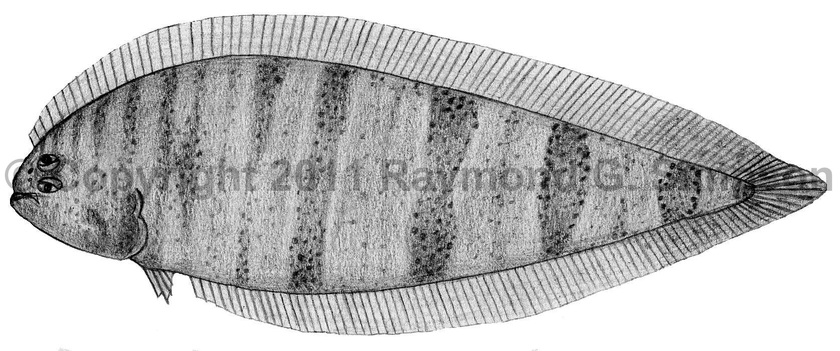
Common Name
Offshore Tonguefish
Year Described
Ginsburg, 1951
Identification
Dorsal Fin Rays: 86-93
Anal Fin Rays: 70-78
Pectoral Fin Rays: none
Pelvic Fin Rays: 4
Caudal Fin Rays: 12
Longitudinal Scale Rows: 66-83
Vertebrae: 46-50
Pterygiophore pattern (1st three interneural spaces): 1-4-3
Other diagnostic characters include: pupillary operculum absent, ocular side lower jaw with fleshy ridge, and scales usually absent from blind side of dorsal and anal fins (sometimes with 1-3 scales at base).
Color
Varying shades of brown with 4-14 narrow crossbands of variable intensity. Inner lining of opercle heavily pigmented, often showing through on outside of ocular side. Peritoneum unpigmented. Crossbands do not extend onto fins. Dorsal, anal, and caudal fins usually lightly pigmented. Blind side pale without melanophores.
Size
Most mature adults from 80-140mm. Maximum 152mm.
Habitat
Inner continental shelf from 1-73m (usually <60m) over sandy/silty bottoms. Juveniles often in estuaries.
Range Map

Range
NC to S. Florida on the U.S. east coast, and the Gulf of Mexico from the panhandle to the Yucatan.
References
Ginsburg, I. 1951. Western Atlantic tonguefishes with descriptions of six new species. Zoologica, Scientific Contributions of the New York Zoological Society 36 (pt 3): 185-201, Pls. 1-3.
Munroe, T.A. 1998. Systematics and ecology of western Atlantic tonguefishes (Symphurus: Cynoglossidae: Pleuronectiformes). Fish. Bull. 96(1):1-182.
Munroe, T. A. 2003. Bothidae (Pp. 1885-1895), Scophthalmidae (Pp. 1896-1897), Paralichthyidae (Pp. 1898-1921), Poecilopsettidae (Pp. 1922-1923), Achiridae (Pp. 1925-1933), Cynoglossidae (Pp. 1934-1959). In: Carpenter. 2003. The living marine resources of the Western Central Atlantic v. 3.